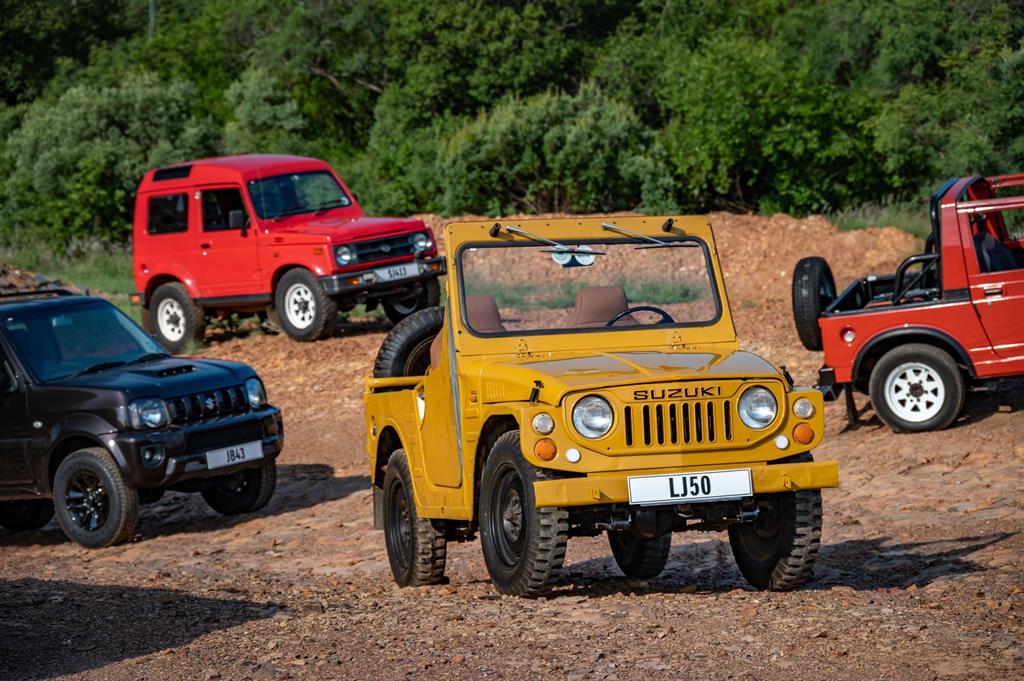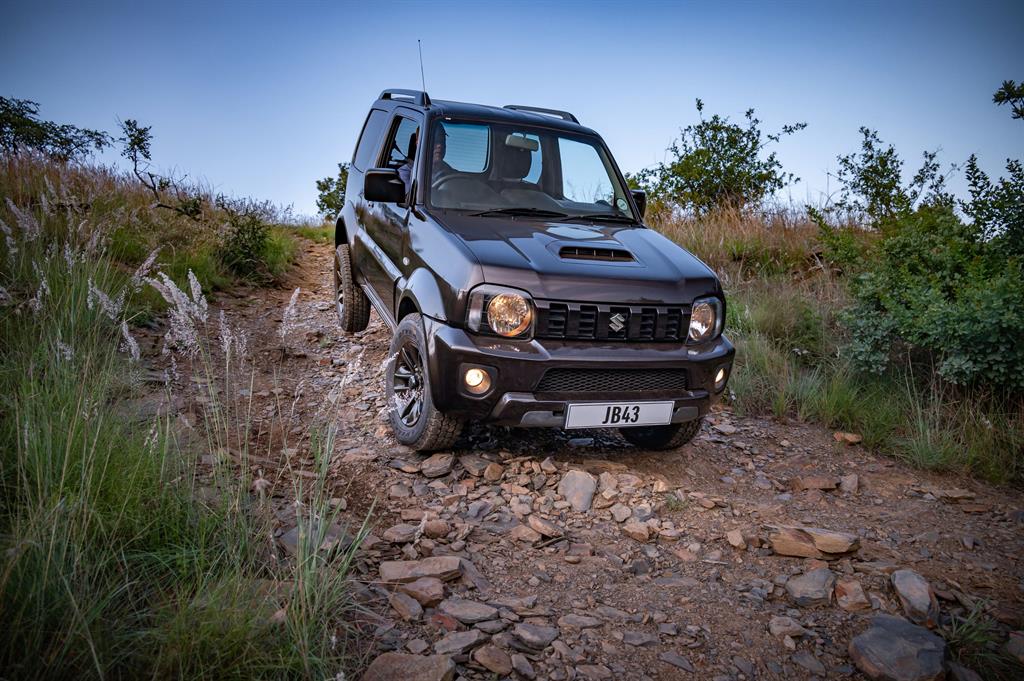The birth of a legend
This year sees the popular Suzuki Jimny celebrating its 50th anniversary, after making its debut in 1970.
The story of the Suzuki Jimny started in 1967.
Flailing Japanese car firm HOPE introduced its Hopestar ON360, a tiny 4x4, built to conform to Japanese Kei car (small car) regulations. Unfortunately, there was to be no hope for it … the ON360 was a momentous commercial failure, with only 15 units eventually produced.
Build quality was said to have been horrible, it was unreliable, and the ‘fuel gauge’ was simply a clear plastic pipe that the driver had to keep an eye on. If there was fuel visible in the pipe, the ON360 was good to go … but if there was no fuel visible in the pipe, best the driver started looking for a filling station, fast!
In a last-ditch effort to salvage something from the project, HOPE put the design for its 4x4 up for sale. Suzuki bought the plans for the equivalent of about R6.5 million, in today’s monetary terms. The company’s engineers then set about righting the wrongs of the original ON360.
The ladder-frame chassis, solid axles and leaf-spring set-up were refined to improve durability and quality, and also to facilitate mass-production. A Suzuki 360cc two-stroke engine replaced the original Mitsubishi engine, and a new body rounded off the new design.
Rigorous endurance testing also ensured optimal reliability, as befits a vehicle from the Suzuki stable.
SEVENTIES
The Suzuki LJ10 (for Light Jeep 10) went on sale in 1970 – and was an instant hit on the sales floor.
The tough-as-nails little 4x4 could run with the big Japanese 4x4s like Toyota’s Land Cruiser and Nissan’s Patrol in an off-road environment, yet was much easier on the pocket to acquire and run.
The LJ10’s on-road prospects were less rosy. Powered by the 360cc engine, the LJ could muster a top speed of about 70km/h. The spare wheel was mounted where one of the rear seats would have been, so it was a three-seater only, with hardly any space for cargo.
By 1976 Suzuki introduced the LJ50.
With the focus no longer on keeping the LJ conforming to Kei car regulations, a bigger 539cc two-stroke engine was fitted, and the spare wheel moved to the rear door. Top speed was increased to a whopping 100km/h … with a bit of a tailwind.
Sales continued to increase around the globe, as the little Suzuki’s popularity and reputation grew.
In 1977 the LJ80 followed.
By that stage Suzuki had started to scale down on its two-stroke motorcycle engine production, so a 797cc four-cylinder, four-stroke engine made its way into the LJ. The fuel tank capacity was increased to a ‘massive’ 40-litre unit to increase range – ironically the same size still used today.
EIGHTIES
The SJ410 was launched in 1981. It was a completely new vehicle, but the well-proven leaf-sprung suspension and live axles set-up was retained. The engine’s capacity was increased to 970cc, and power peaked at 33kW.
Two years later the SJ413 followed, with Suzuki increasing the capacity of the mill to 1 324cc – the largest capacity engine in Suzuki’s catalogue in 1983.
Towards the end of the SJ413’s life cycle it became clear that many customers were using their vehicles as daily runners, and occasional off-road machines. So, there was a clear shift towards more on-road comfort, without sacrificing the lightweight Suzuki’s legendary off-road prowess.
NINETIES
And so a coil-sprung front suspension was introduced in the early Nineties, along with in-cabin luxuries such as air-conditioning, electric windows and even tape-deck/radio sound systems.
The third-generation of Suzuki’s little 4x4 was launched in 1998.
Now branded as Jimny the 4x4 featured a new coil-sprung suspension set-up, automatically locking front hubs, a dial to select between 2WD, 4WD High and 4Low (instead of the traditional second gear lever, or “kort stokkie”), and a new 16-valve 1.3-litre petrol engine producing 63kW.
It was still very capable in an off-road environment (even without any electronic driving aids or locking differentials) and fared reasonably well in the city.
THIRD GENERATION
The third-generation Jimny remained largely unchanged for the next 20 years, give or take a few facelifts and specification updates.
It was only in 2018 that Suzuki introduced the current generation Jimny. Now the company can, much like in the Seventies, hardly keep up with demand for the popular little 4x4.
“The Suzuki Jimny is a legend in its own time. In the Seventies it rewrote the 4x4 rulebook, demonstrating that bigger is not always better. And it is still the compact 4x4 to beat today,” says Andre Venter, divisional manager of sales and marketing at Suzuki Auto South Africa.
“The Jimny’s reliability, genuine off-road ability, comfortable cabin with all the modern amenities and low running costs have clearly served to further bolster its reputation. The award-winning styling is pretty much spot-on too – the similarities with a classic like the LJ50 is clear, yet it is modern and trendy.”
“Judging by the world-wide demand for the latest Jimny, this legend is far from a done deal, even after 50 years,” says Venter. - MotorPress
Flailing Japanese car firm HOPE introduced its Hopestar ON360, a tiny 4x4, built to conform to Japanese Kei car (small car) regulations. Unfortunately, there was to be no hope for it … the ON360 was a momentous commercial failure, with only 15 units eventually produced.
Build quality was said to have been horrible, it was unreliable, and the ‘fuel gauge’ was simply a clear plastic pipe that the driver had to keep an eye on. If there was fuel visible in the pipe, the ON360 was good to go … but if there was no fuel visible in the pipe, best the driver started looking for a filling station, fast!
In a last-ditch effort to salvage something from the project, HOPE put the design for its 4x4 up for sale. Suzuki bought the plans for the equivalent of about R6.5 million, in today’s monetary terms. The company’s engineers then set about righting the wrongs of the original ON360.
The ladder-frame chassis, solid axles and leaf-spring set-up were refined to improve durability and quality, and also to facilitate mass-production. A Suzuki 360cc two-stroke engine replaced the original Mitsubishi engine, and a new body rounded off the new design.
Rigorous endurance testing also ensured optimal reliability, as befits a vehicle from the Suzuki stable.
SEVENTIES
The Suzuki LJ10 (for Light Jeep 10) went on sale in 1970 – and was an instant hit on the sales floor.
The tough-as-nails little 4x4 could run with the big Japanese 4x4s like Toyota’s Land Cruiser and Nissan’s Patrol in an off-road environment, yet was much easier on the pocket to acquire and run.
The LJ10’s on-road prospects were less rosy. Powered by the 360cc engine, the LJ could muster a top speed of about 70km/h. The spare wheel was mounted where one of the rear seats would have been, so it was a three-seater only, with hardly any space for cargo.
By 1976 Suzuki introduced the LJ50.
With the focus no longer on keeping the LJ conforming to Kei car regulations, a bigger 539cc two-stroke engine was fitted, and the spare wheel moved to the rear door. Top speed was increased to a whopping 100km/h … with a bit of a tailwind.
Sales continued to increase around the globe, as the little Suzuki’s popularity and reputation grew.
In 1977 the LJ80 followed.
By that stage Suzuki had started to scale down on its two-stroke motorcycle engine production, so a 797cc four-cylinder, four-stroke engine made its way into the LJ. The fuel tank capacity was increased to a ‘massive’ 40-litre unit to increase range – ironically the same size still used today.
EIGHTIES
The SJ410 was launched in 1981. It was a completely new vehicle, but the well-proven leaf-sprung suspension and live axles set-up was retained. The engine’s capacity was increased to 970cc, and power peaked at 33kW.
Two years later the SJ413 followed, with Suzuki increasing the capacity of the mill to 1 324cc – the largest capacity engine in Suzuki’s catalogue in 1983.
Towards the end of the SJ413’s life cycle it became clear that many customers were using their vehicles as daily runners, and occasional off-road machines. So, there was a clear shift towards more on-road comfort, without sacrificing the lightweight Suzuki’s legendary off-road prowess.
NINETIES
And so a coil-sprung front suspension was introduced in the early Nineties, along with in-cabin luxuries such as air-conditioning, electric windows and even tape-deck/radio sound systems.
The third-generation of Suzuki’s little 4x4 was launched in 1998.
Now branded as Jimny the 4x4 featured a new coil-sprung suspension set-up, automatically locking front hubs, a dial to select between 2WD, 4WD High and 4Low (instead of the traditional second gear lever, or “kort stokkie”), and a new 16-valve 1.3-litre petrol engine producing 63kW.
It was still very capable in an off-road environment (even without any electronic driving aids or locking differentials) and fared reasonably well in the city.
THIRD GENERATION
The third-generation Jimny remained largely unchanged for the next 20 years, give or take a few facelifts and specification updates.
It was only in 2018 that Suzuki introduced the current generation Jimny. Now the company can, much like in the Seventies, hardly keep up with demand for the popular little 4x4.
“The Suzuki Jimny is a legend in its own time. In the Seventies it rewrote the 4x4 rulebook, demonstrating that bigger is not always better. And it is still the compact 4x4 to beat today,” says Andre Venter, divisional manager of sales and marketing at Suzuki Auto South Africa.
“The Jimny’s reliability, genuine off-road ability, comfortable cabin with all the modern amenities and low running costs have clearly served to further bolster its reputation. The award-winning styling is pretty much spot-on too – the similarities with a classic like the LJ50 is clear, yet it is modern and trendy.”
“Judging by the world-wide demand for the latest Jimny, this legend is far from a done deal, even after 50 years,” says Venter. - MotorPress








Comments
Namibian Sun
No comments have been left on this article